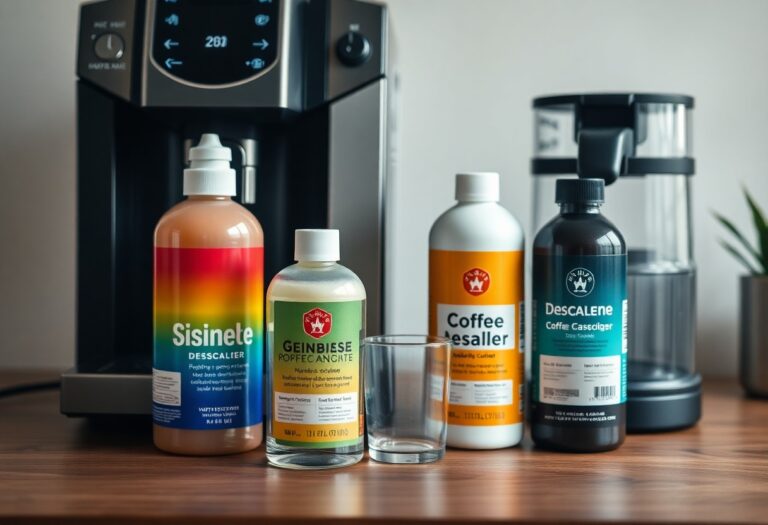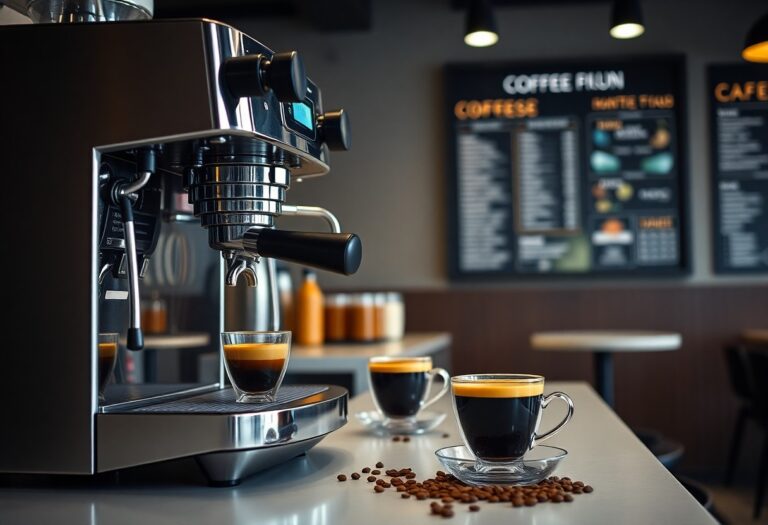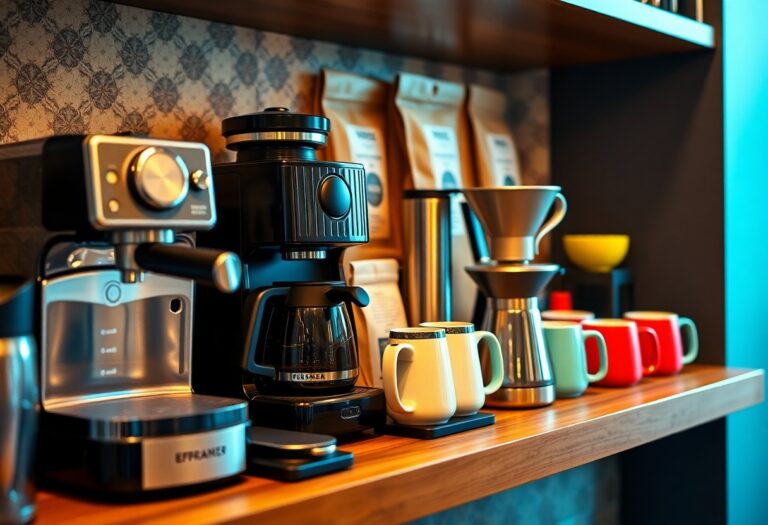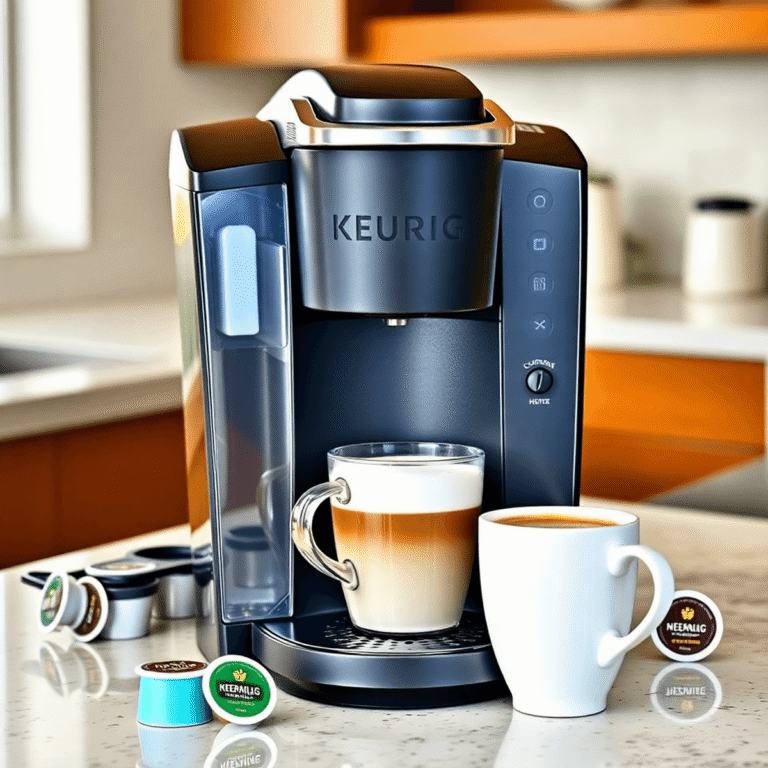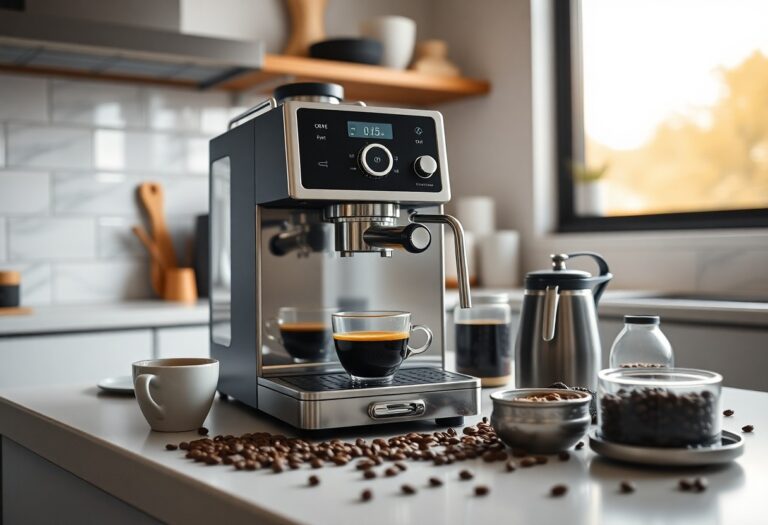What Coffee to Use in a Filter Coffee Machine – Optimal Selection
Most coffee lovers wonder what type of coffee best suits their filter coffee machine. Choosing the right coffee can elevate your brewing experience, enhancing the flavor and aroma of your cup. You should focus on medium to coarsely ground coffee, which allows for optimal extraction and prevents over-brewing. Additionally, selecting freshly roasted, high-quality beans will significantly impact your brew’s richness and complexity. In this post, we’ll guide you through the ideal coffee varieties and blends to ensure you achieve that perfect cup every time.
With the right coffee selection, you can elevate your filter coffee experience to new heights. The choice of coffee beans directly impacts the flavor, aroma, and overall quality of your brew. You might be tempted by various options, but understanding your preferences is key. Consider the roast level, origin, and grind size to optimize your filter coffee machine. For more detailed insights on coffee bean selection, check out this Coffee Bean Selection and Grind Settings for Super … guide.

Key Takeaways:
- Opt for medium to coarsely ground coffee for optimal extraction and flavor in a filter coffee machine.
- Choose high-quality, freshly roasted coffee beans for the best results, ideally used within 2-4 weeks of roasting.
- Consider the coffee-to-water ratio, typically 1:15 to 1:18, to achieve a balanced cup of coffee.
- Explore various coffee origins and blends to find your preferred flavors and aromas that suit your taste.
- Store coffee beans in an airtight container in a cool, dark place to maintain freshness and flavor over time.
Key Takeaways:
- Choose coffee beans that are specifically labeled for drip or filter coffee, as they are usually ground to the ideal consistency.
- Opt for fresh, high-quality coffee beans to enhance flavor; consider specialty or single-origin coffees for unique profiles.
- Grind size is important; use a medium grind for filter coffee machines to ensure optimal extraction.
- Pay attention to roast levels; medium to medium-dark roasts generally work best for a balanced cup.
- Experiment with different coffee-to-water ratios to find the taste that suits your preferences best.
The Anatomy of Coffee Flavor Profiles
Understanding coffee flavor profiles opens up a world of taste experiences. Each cup tells a story shaped by factors like acidity, body, aroma, and the origin of the beans. These elements intertwine to create a unique sensory experience. By exploring these aspects, you gain the ability to tailor your coffee selection to match your palate, whether you prefer a bright, fruity flavor or a rich, full-bodied brew.
Unpacking Acidity, Body, and Aroma
Acidity contributes a vibrant brightness to coffee, while body refers to the fullness perceived in your mouth; both are important in crafting your ideal cup. Aroma encompasses the fragrance and olfactory characteristics, which elevate your tasting experience and can range from floral to nutty or chocolatey. Together, these attributes help shape your overall enjoyment and personal preferences regarding coffee.
How Origin Affects Taste
The geographical origin of coffee beans plays a significant role in determining flavor. Coffee from regions like Ethiopia typically showcases bright acidity and fruity notes, while beans from Brazil tend to present a smoother, nuttier profile. Location, altitude, and climate influence not only the bean characteristics but also the processing method, each contributing further nuances to your cup.
For instance, high-altitude regions like Colombia often produce beans with complex flavor profiles due to slower maturation, enhancing sweetness and acidity. Meanwhile, beans grown in lower altitudes might offer a more earthy or chocolatey flavor due to differing growing conditions. Exploring coffee from various origins allows you to discover a spectrum of flavors and refine your selection, so you can find what truly resonates with your preferences.

The Flavor Spectrum: Choosing Coffee Beans for Filter Machines
Your choice of coffee beans significantly affects the flavor profile of your brew when using a filter coffee machine. The subtle nuances in taste, acidity, and aroma vary between different types of coffee, making it imperative to select beans that align with your personal preference. Light roasts offer bright, fruity flavors, while medium-dark roasts provide a more balanced sweetness and richness. Experimenting with various origins, processing methods, and roast levels will help you make the most delightful cup tailored to your palate.
Arabica vs. Robusta: What Your Brew Tells You
You’ll often encounter two primary species of coffee: Arabica and Robusta. Arabica beans are typically sweeter, with a range of complex flavors and higher acidity, making them ideal for filter brewing. In contrast, Robusta beans have a stronger, more bitter taste and a higher caffeine content. If you prefer a smooth and nuanced cup, Arabica is your go-to, while Robusta may satisfy those craving a bolder brew with an earthy profile.
Single-Origin vs. Blends: Finding Your Perfect Balance
Single-origin coffees showcase the unique flavors of a specific region, highlighting distinct characteristics such as fruity, floral, or nutty notes. On the other hand, blends combine beans from different origins to create a balanced flavor profile. A blend can offer consistency, while single-origin coffee presents a unique tasting experience that varies with each batch. Selecting between these options ultimately depends on whether you prioritize exploring diverse flavors or enjoying a harmonized blend.
Many coffee enthusiasts appreciate the excitement of single-origin beans for their ability to reveal the terroir’s character, which varies seasonally and geographically. For example, Ethiopian Yirgacheffe is renowned for its vibrant citrus and floral notes, while a Guatemalan coffee might offer chocolate and caramel flavors. Conversely, blends like Espresso or House blends provide a reliable taste profile, perfect for those who prefer a smoother, more familiar cup. Ultimately, you can find joy in both; consider using single-origin coffees for special occasions and blends for everyday enjoyment.
Grinds That Make a Difference
Your choice of grind size can significantly impact the flavor extraction in filter brewing. It’s not just about picking your favorite coffee; it’s about understanding how the grind interacts with water during the brewing process. A fine grind can lead to over-extraction, resulting in bitter flavors, while a coarse grind may under-extract, yielding a weak cup. For a comprehensive look at how grind affects your coffee, check out A Guide to Choosing the Best Coffee Filter.
The Science of Grind Size for Filter Brewing
Grind size acts as a bridge between the water and coffee during brewing, affecting the extraction rate. For a filter coffee machine, a medium grind allows water to flow evenly, facilitating a balanced extraction without clogging the filter. This typically means aiming for a consistency akin to granulated sugar. If you’re using a pre-ground coffee, look for brands that specify “drip” or “filter” grind on the packaging for best results.
Fresh Vs. Stale: The Impact of Grind Timing
The timing of your grind plays a pivotal role in the freshness and flavor of your coffee. Freshly ground coffee beans release CO2, which aids in the extraction process, enhancing the overall flavor profile. Grinding just before brewing can produce a brighter, more complex cup, as opposed to using pre-ground coffee, which often loses its aromatic properties over time.
As coffee sits after being ground, it begins to oxidize, leading to a dull taste. In fact, flavor can degrade notably within hours due to the loss of volatile compounds. Aim to grind your beans right before brewing to maximize freshness and flavor. By doing so, you not only preserve the aromatic oils but also enhance the overall sensory experience of your cup. Investing in a good burr grinder can make a world of difference in how much you enjoy each brew.
Grind Size Matters: Unlocking the Potential of Your Coffee
The grind size of your coffee is a game changer, directly influencing extraction and flavor. Choosing the right texture can enhance your brewing experience, ensuring that all the delightful notes in your coffee shine through. Whether you prefer a stunningly bold cup or a smooth, nuanced brew, adjusting your grind size is vital for maximizing your coffee’s potential.
The Science of Grinding: Coarse vs. Medium Fine for Filter Brewing
Coarse and medium-fine grinds serve different purposes in filter brewing. A coarse grind is best for longer brewing times, such as French press or cold brew, as it allows for slower extraction, emphasizing bold flavors. On the other hand, a medium-fine grind strikes the right balance for drip coffee machines, enabling quicker extraction without over-extracting bitterness, enhancing your cup’s overall flavor profile.
Consistency is Key: Why Even Distribution Enhances Flavor
Uniform grind size is vital for flavor consistency, ensuring each coffee particle extracts at the same rate. An uneven grind leads to an inconsistent brew, where some particles may over-extract while others under-extract. Striving for evenness means you draw out the best flavors without unwelcome bitterness or sour notes, creating a harmonious cup that celebrates the unique character of your chosen beans.
Even distribution allows for optimal extraction, with each coffee particle contributing to the final flavor profile. Think about it: each coffee grind should interact with water uniformly, creating a seamless flow. If some particles are too fine, they risk bitterness, while larger ones might result in under-extraction, producing a sour taste. Investing in a quality burr grinder can make a significant difference, as it yields a more consistent grind than blade grinders, maximizing your coffee’s flavors and aromas. Enjoy experimenting with your grind size, and discover how it unlocks new dimensions in your favorite brews.
Roast Levels and Their Influence
Understanding roast levels is vital for extracting the best flavors in your cup. The depth of roast affects the acidity, body, and overall taste profile of your coffee. Generally, light roasts highlight the coffee’s origin characteristics and brightness, while dark roasts deliver bold, deep flavors often with hints of chocolate and smokiness. For the best results, balance your choice with the right grind size, as discussed in The right grind: the key to perfect filter coffee.
Light, Medium, and Dark: What Works Best in Filters
For filter coffee, medium roasts are often preferred as they strike a balance between flavor complexity and acidity, providing a rich brew without overwhelming bitterness. Light roasts can bring out unique floral and fruity notes, but may result in a sudden, acidic punch that requires careful brewing. Dark roasts offer a robust experience with lower acidity but may mask nuanced flavors. Your choice ultimately depends on your taste preferences.
Transitional Notes: How Roast Affects Brew Dynamics
Transitional notes in coffee can significantly influence brew dynamics, with roast levels playing a vital role. Light roasts tend to retain more acidity and showcase bright, complex flavors that may evolve as they cool, while medium roasts can offer rounded profiles with balanced sweetness and body. Dark roasts often yield a syrupy texture, but can lead to a simplified flavor experience, limiting the coffee’s character. As you experiment, note how variations in roast impact extraction and overall enjoyment.
As you explore the effects of roast levels, consider how specific compounds in coffee change during the roasting process. For instance, acids in light roasts tend to degrade with longer extraction times, potentially resulting in bitterness if bypassed. Conversely, the caramelization of sugars in medium and dark roasts can enhance richness but may diminish the brightness and unique flavors present in the beans. Understanding these interactions helps you fine-tune your brew parameters for maximum flavor and enjoyment.
Freshness Factor: Why Your Coffee’s Age Is Crucial
The age of your coffee beans directly influences the taste and quality of each cup you brew. Freshly roasted coffee can deliver vibrant flavors and rich aromas, while older beans tend to lose their essence, leading to dull and flat coffee. Always check the roast date on the packaging, as coffee is best consumed within 2-4 weeks of roasting for optimal flavor. For a deeper explore this topic, check out the Guide To Home Coffee Makers.
The Impact of Roast Dates on Flavor and Aroma
Freshly roasted coffee beans release a plethora of complex flavors that diminish over time. Ideally, you should aim for beans roasted within the last two weeks for the best aroma and taste experience. After this period, stale oils and gases can accumulate, muting the coffee’s vibrant notes and making it taste flat and lifeless. Knowing the roast date allows you to experience the coffee at its peak.
How to Store Beans for Optimal Freshness
Storing your coffee beans properly is crucial to maintain freshness and flavor. Ideal storage conditions include a cool, dark place in an airtight container. Avoid exposure to light, heat, and moisture, as these factors can accelerate the aging process. Purchasing smaller quantities of beans that you can consume within a week or two ensures greater enjoyment and less waste.
Using opaque, airtight containers helps shield your coffee from light and airflow, both of which can rapidly degrade its quality. Glass jars and vacuum-sealed bags work well, but always keep them away from direct sunlight, and never store beans in the fridge—doing so can introduce moisture that harms flavor quality. If buying in bulk, consider freezing portions for longer-term storage but remember to let them reach room temperature before brewing.

Quality Indicators for Selecting Beans
Selecting high-quality coffee beans is vital for brewing a delicious cup. Look for beans that are labeled as specialty coffee, which signifies they meet strict quality standards and are typically sourced from specific regions known for their unique flavor profiles. Checks like the presence of a roast date on the packaging can also serve as an indicator, as fresher beans tend to yield superior flavor and aroma.
Identifying Specialty Coffee: What to Look For
Specialty coffee often features unique flavor notes, single-origin sourcing, and high-quality processing methods. Seek out beans that have a score of 80 or higher on the SCA scale, which assesses the coffee’s taste and aroma qualities. Additionally, certifications such as Fair Trade or organic can indicate a premium product.
The Role of Freshness and Packaging
Freshness in coffee directly impacts its flavor; beans are best enjoyed within two to four weeks of roasting. Airtight, vacuum-sealed packaging is ideal for preserving freshness and preventing oxidation. If you can find beans packaged in bags with one-way valves, they allow for gases to escape without letting air in, ensuring your coffee remains tasty for longer.
Securing truly fresh coffee often means purchasing from local roasters or online retailers that prioritize rapid delivery. After roasting, the beans release gases that impact taste; thus, packaging designed to release those gases without compromising freshness is beneficial. When you prioritize freshness and appropriate packaging, you enhance your coffee experience, ensuring every cup crafted in your filter coffee machine is rich, aromatic, and bursting with flavor. Avoid buying pre-ground coffee or beans stored for long durations, as aging compromises quality and disappointing results.

Understanding Roast Profiles: Matching Coffee Characteristics to Personal Preference
Roast profiles play a significant role in shaping the flavor and aroma of coffee. Each roast level, from light to dark, has unique characteristics that can either complement or contrast with your taste preferences. By understanding these profiles, you can select blends that align with your desired drinking experience. Pay attention to how roast levels influence acidity, body, and sweetness, which can significantly alter your enjoyment of a cup.
Light, Medium, and Dark Roasts: What Each Offers
Light roasts offer bright acidity and often feature floral or fruity notes, making them perfect for those who enjoy a lively cup. Medium roasts strike a balance between acidity and body, showcasing a range of flavors, from caramel to nuts. Dark roasts provide deep, rich flavors with chocolate and smoky undertones, ideal for drinkers seeking bold, intense brews. Your choice will depend on the flavor intensity you prefer in your daily coffee ritual.
Flavor Notes: Recognizing the Nuances in Each Roast
Understanding flavor notes enhances your coffee-drinking experience by allowing you to appreciate the various tastes present in different roasts. Light roasts commonly yield bright, fruity flavors like berry or citrus, while medium roasts often display sweetness from caramelization, with hints of chocolate or nuts. Dark roasts, characterized by their robust profiles, can offer rich, smoky flavors with underlying notes of dark chocolate or even spices. These nuances can transform your coffee experience into an exploration of taste.
By experimenting with various roasts, you’ll discover that flavor notes can evoke distinct feelings and memories. For example, a light roast might remind you of a refreshing spring morning with its bright citrus notes, while a dark roast may evoke comfort during colder months with its warm, chocolatey essence. Engaging your senses to identify these subtleties not only elevates your own enjoyment but also helps you express your preferences when discussing coffee with fellow enthusiasts. The more you explore, the richer your coffee journey will be.
The Art of Blending for Balance
Crafting the perfect cup often entails an artful blend of distinct coffee beans to achieve a harmonious balance of flavors. By combining different origins, varieties, and roast levels, you can create a coffee experience that is both complex and satisfying. This intricate process involves careful consideration of acidity, sweetness, body, and aroma. Exploring various flavors from diverse regions not only enhances your brew but allows you to tailor cups that resonate with your taste preferences.
Crafting Custom Blends for Unique Brews
To design a custom blend that stands out, start by selecting beans with complementary characteristics. For instance, pairing a bright Ethiopian Yirgacheffe with a smooth Brazilian Santos can produce a blend with vibrant acidity and mellow sweetness. Experimentation is key; adjust the ratios until you find a combination that pleases your palate. Document your process so you can recreate or tweak your unique brew in the future.
Profiling Popular Coffee Blends for Filter Machines
Popular coffee blends designed for filter machines often showcase a mix of flavor notes that cater to a wide audience. A classic example is a breakfast blend, which typically combines medium-roasted Central American beans with darker-roasted South American varieties. This combination delivers a balanced cup characterized by mild acidity, medium body, and a smooth finish with notes of chocolate and caramel. Each brand might present unique blends, making it worth sampling various options to find your preferred profile.
For instance, one popular blend, the “House Blend,” might feature a 70% Colombian bean base for its rich flavor paired with 30% Sumatran beans for earthy undertones. This blend achieves a notable depth in taste while remaining approachable for everyday drinking. Some roasters also enhance their blends with seasonal beans, adding a layer of complexity that keeps your morning ritual fresh and exciting. By exploring these popular blends, you can discover new flavor profiles that harmonize beautifully for your filter coffee machine.
The Role of Water: Elevating Your Coffee Experience
Water is often an overlooked component in the coffee brewing process, yet it significantly influences the overall flavor and quality of your cup. The chemistry behind coffee extraction requires the right balance of minerals, acidity, and temperature in water to enhance the flavors of your chosen beans. By optimizing your water quality and brewing conditions, you can elevate your coffee experience to new heights.
Water Quality: Why It Matters More Than You Think
The quality of water used in brewing can dictate the flavors that emerge in your coffee. Utilizing filtered or bottled water, instead of tap water laden with chemicals and impurities, allows the natural notes of your beans to shine. Ideally, mineral content should be balanced; water that is too soft or too hard can negatively impact flavor extraction, resulting in a dull or overly bitter cup.
Temperature and Brewing Time: Science Behind the Perfect Cup
Optimal brewing temperature ranges between 195°F and 205°F (90°C – 96°C). Staying within this range is vital; too low a temperature can lead to under-extraction, while too high can burn the coffee grounds. Timing your brew is equally important: for a filter coffee machine, 4-6 minutes is typically ideal. Striking the right balance of temperature and brewing time plays a pivotal role in crafting a perfect cup that is aromatic, flavorful, and satisfying.
Further Insights on Temperature and Brewing Time
| Aspect | Details |
|---|---|
| Extraction | Optimal extraction of flavors occurs within the ideal temperature range. |
| Consistency | Maintaining water temperature throughout brewing creates uniform flavor. |
| Experimentation | Adjusting time and temperature can yield unique flavor profiles. |
| Impact of Minerals | Certain minerals enhance extraction, lending sweetness and depth to your coffee. |
Conclusion
Drawing together the necessary aspects of selecting coffee for your filter coffee machine, you should prioritize freshly roasted, high-quality beans that suit your taste preferences. Opt for medium grind coffee to ensure optimal extraction and flavor. Be mindful of the coffee’s origin, roast profile, and freshness to elevate your brewing experience. By understanding and choosing the right coffee, you can enjoy a consistently satisfying cup that enhances your daily ritual.
Conclusion
The key to achieving the best flavor from your filter coffee machine lies in selecting the right coffee beans. You should opt for medium to light roasts that offer balance and clarity. Freshly ground beans elevate your brewing experience, so invest in a quality burr grinder. Always choose whole beans with a roast date for optimal freshness, and consider a blend that complements your taste preferences. With these guidelines, you can enhance your coffee enjoyment and ensure a satisfying brew every time.
FAQ
Q: What type of coffee beans is best for a filter coffee machine?
A: For a filter coffee machine, medium to dark roast coffee beans are often the preferred choice. These roasts tend to have balanced flavors and produce rich brews. Look for varieties labeled as ‘breakfast blends’ or ‘medium roasts’ to find beans that work well for drip brewing.
Q: Should I use whole beans or pre-ground coffee for my filter coffee machine?
A: Whole beans are typically recommended for the freshest taste. Grinding your own beans just before brewing helps to retain the coffee’s aroma and flavor. If you opt for pre-ground coffee, choose a grind specifically designed for filter brewing, as too fine a grind can lead to over-extraction and bitterness.
Q: What grind size should I use for my filter coffee machine?
A: For filter coffee machines, a medium grind size is ideal. This grind size resembles granulated sugar and allows for optimal water flow during the brewing process. If your coffee is too coarsely ground, it may result in weak coffee, while too fine a grind can lead to a bitter taste.
Q: How important is the roasting date of coffee for filter brewing?
A: The roasting date is significant as it affects the freshness of the coffee. Ideally, coffee should be consumed within a few weeks of its roast date for the best flavor. Purchasing beans that are roasted recently ensures that your brewed coffee will have a full-bodied taste and vibrant aroma.
Q: Can I use flavored coffee in a filter coffee machine?
A: Yes, flavored coffees can be used in a filter coffee machine, but be cautious of the quality. Choose high-quality flavored coffee that uses natural flavoring processes to ensure a pleasant taste. However, keep in mind that strong flavors may alter the nuances of the coffee’s origin, so choose flavors that complement the coffee well.


